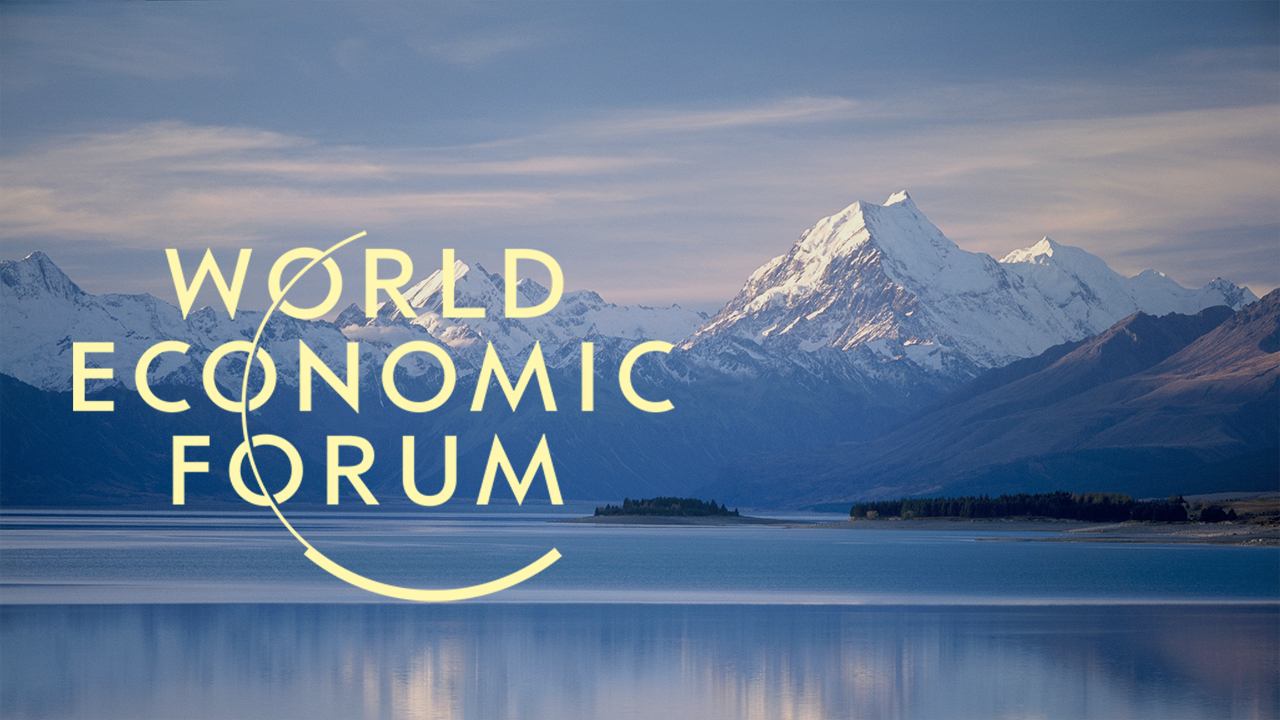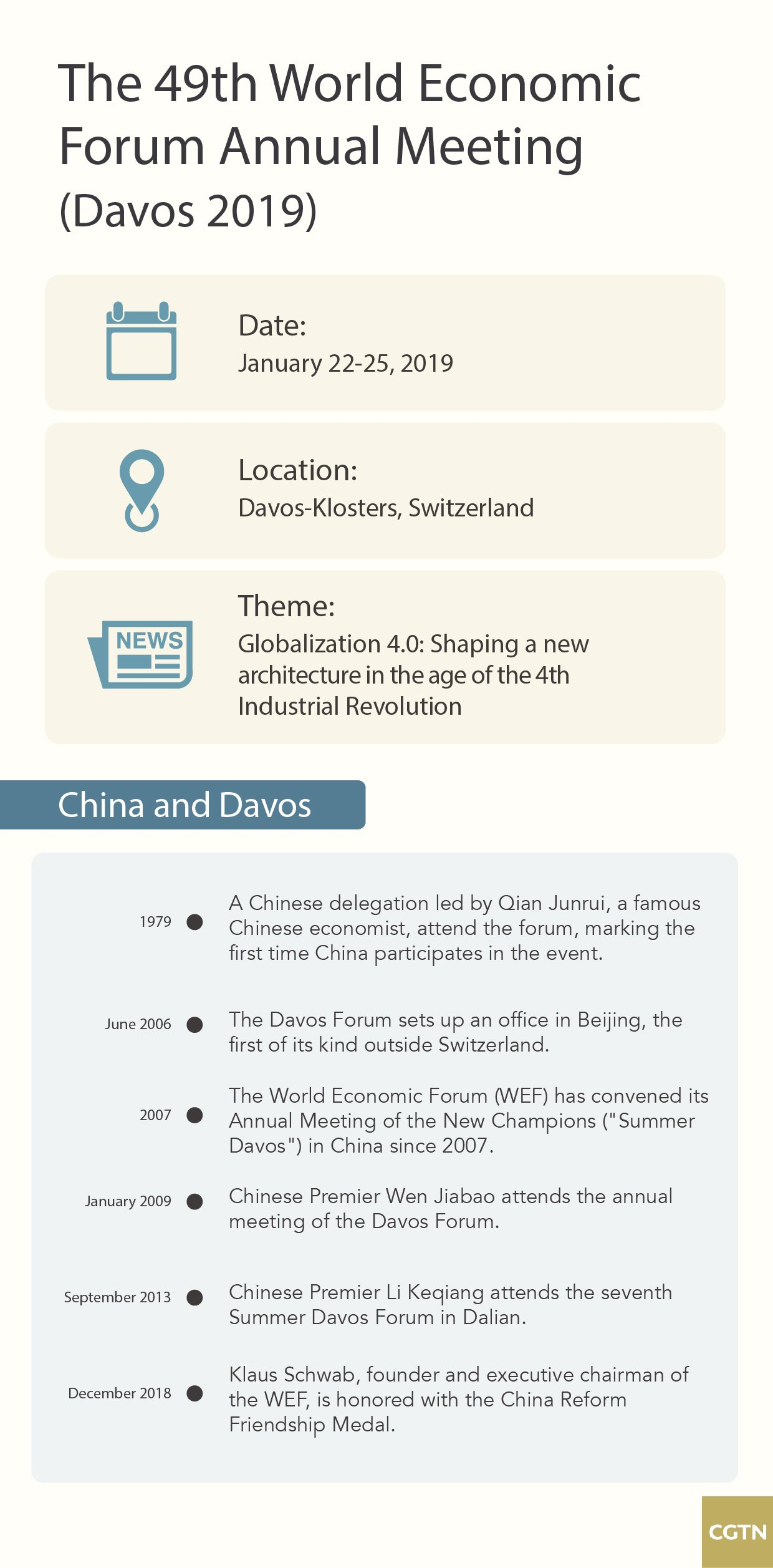
Money Stories
21:06, 20-Jan-2019
Infographic: Things you need to know about China at Davos 2019
CGTN




The 49th World Economic Forum (WEF) Annual Meeting will be held from January 22-25 in Davos-Klosters, Switzerland, under the theme of Globalization 4.0: Shaping a new architecture in the age of the 4th Industrial Revolution.
Official data shows that there will be over 3,000 people from 110 countries participating in the winter Davos this year, many of whom are CEOs or politicians.
By then, there will be over 350 sessions and workshops in the four-day event, and the six topics below will undoubtedly act as the most hotly-debated issues concerning China.
Belt and Road Initiative: China's trillion-dollar challenge
Six years have passed since Chinese President Xi Jinping proposed the Belt and Road Initiative (BRI) in the autumn of 2013.
China's trade with the countries along the BRI has surpassed five trillion U.S. dollars, with outward direct investment (ODI) amounting to over 60 billion U.S. dollars and creating some 200,000 jobs locally.
Its concept of "extensive consultation, joint contribution and shared benefits" has earned wide acknowledgment in the global arena, showcasing a promising prospect.
How the most ambitious infrastructure project in human history will succeed as an engine of development and growth will be under the limelight at the 49th WEF Annual Meeting.
China's economic outlook
Beijing and Washington have been at odds over trade issues in the past year, pricking a thorn in the world economy and leaving a gripping pain hard to overcome.
On the flip side, uncertainties still loom over China's economic outlook under the dual function of emerging domestic and global trends, from the likes of rising wages, competitive pressures, supply-side reform and the industrial upgrade the world's second largest economy is going through.
The skies were overcast, but then out came the sun.
The trade talks between China and the U.S. will proceed to the next step as scheduled, after the latest vice-ministerial level negotiations concluded with "extensive, in-depth and detailed exchanges."
China's policymakers are also ramping up efforts to step up stimulus measures regarding tax cuts, fee deduction, and employment stabilization.
Globalization 4.0: How China is shaping the future of global commerce
Once "the world's factory" and now a global innovation powerhouse, China has been investing heavily in technological innovation via a host of measures and policies to encourage creativity and entrepreneurship.
China is among the top 20 most-innovative economies in the annual Global Innovation Index (GII) ranking published last July by Cornell University and the World Intellectual Property Organization (WIPO).
Chinese President Xi Jinping said at the opening ceremony of the first China International Import Expo that a science and technology innovation board will be launched at the Shanghai Stock Exchange to shore up innovation.
How China is shaping the future of global commerce and how China will shape the next era of globalization are currently garnering worldwide attention.
Strategic outlook on the digital economy
Official data show that China's digital economy grew to 27.2 trillion yuan (about 3.94 trillion U.S. dollars) last year, up 20.3 percent from previous year and making up 32.9 percent of the country's GDP.
China's first 5G subway station was officially put into service in 2019, and the country is expected to become the world's largest 5G market by 2025, accounting for 430 million 5G connections, or one-third of the global total.
At the session of Davos, three parts will be on the agenda, covering growth of virtual and augmented reality applications, coalition to invest in building 5G infrastructure and public policy changes on data and artificial intelligence (AI).
Emerging markets outlook
Though the trend of trade protectionism has been repeatedly criticized, it is still on the rise, yet no one will emerge as a winner.
Emerging market economies, including China, are unquestionably suffering the most from growing protectionism and tightening monetary conditions. How are they shying away from a hard economic landing?
Global value chains: Race to the top
Globalization implies that as the world becomes more integrated, the production of goods and services is generally extended to over one country and even more to maximize profits.
Some hailed it as a great idea as it provides developing economies a chance to start industrializing, as many of them are lagging behind developed economies and need a platform to build critical links of the industrial chain.
China is on the right track to transform its development model and emphasizing innovation, in hopes of climbing the ladder and moving up to high-value added activities.

SITEMAP
Copyright © 2018 CGTN. Beijing ICP prepared NO.16065310-3
Copyright © 2018 CGTN. Beijing ICP prepared NO.16065310-3